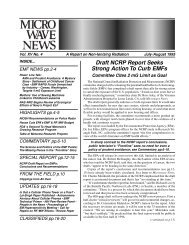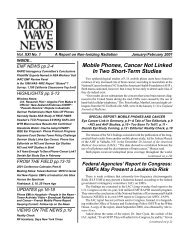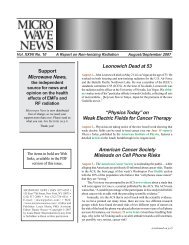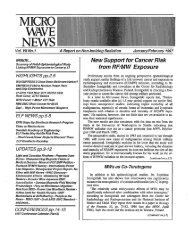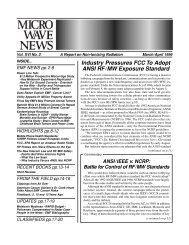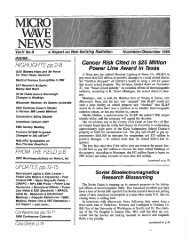Microwave News - November/December 1990
Microwave News - November/December 1990
Microwave News - November/December 1990
You also want an ePaper? Increase the reach of your titles
YUMPU automatically turns print PDFs into web optimized ePapers that Google loves.
ELF NEWS<br />
The Talk of Denver<br />
This year's DOE power line review* offered few sqrises.<br />
These were no bombshells in Denver, CO, ascompared to Dr.<br />
GeneMatanoski'srevelalionsatlastyear'sm~ inPortland,<br />
OR. If there was one lesson to take home from Denver, it was<br />
that the electromagnetic field Q3F) problem remains elusive,<br />
with no agreement yet on the most imporfant aspect of EMF<br />
exposuresTobespecSc,whatisitaboutthemagnetiCfie1dthat<br />
could pmmote cancer? And are the epidemiologists measuring<br />
theriphtparametersin~attemptstoestimateEMFexposures?<br />
The thesis that the pineal gland is sensitive to EMFs got a<br />
boost from preliminary data indicating a suppression of nighttime<br />
melatonin levels among two speciesexposed to power line<br />
fields. Dr. Fred Stormshak of Oregon State University in<br />
Carvallis reported that ewes living under a 5-<br />
with ambient magnetic fields of 15-50 mG andelectric fields of<br />
4-75 kV--had a 7.0-2546 reduction in serum melatonin.<br />
Outside the lecture hall, there was talk of even larger<br />
reductions among baboons exposed to 60 Hz EMFs at the<br />
Southwest Research Institute (SWRI) in San Anto~o~ TX.<br />
SWRI's Dr. Walter Rogers did not formally present these<br />
resultsandrefusedtodiscussthem."I'mnotgoingtotalktoyou<br />
abwt this. The information belongs to the sponsors," Rogm<br />
told <strong>Microwave</strong> <strong>News</strong> as he walked away from an interview.<br />
nieSWRIprojectispWy WbytheCenhalR-h<br />
Institute of Electric Power Industry (CRIEF'Q in Tokyo, Japan.<br />
Izumi Nihimncaof CRIEPI's AbikoResearch Laboratory also<br />
declined to discuss the experiment, saying only that there were<br />
no results yet<br />
Dr. Bary Wilson, who, with other members of the BaueUe<br />
group in Richland, WA, has been working on the pineal-EMF<br />
link for over a decade, repmi that intermittent exposures to<br />
magneticfieldsaremore@ectivethancontinuousexposuresin<br />
reducing nighttime melatonin in rats.<br />
The impoitance of intermittent exposures was a thread that<br />
ranthroughmanyofthet?Iks.Dr.RussefRei~<br />
of Teiw Health Science Center in San Antonio presented<br />
results suggesting that the on-and-off switching of a magnetic<br />
field is a key parameter for explaining obse~ed changes in<br />
pineal function (seeMWN, S/090).AndDr.CharlesGmhamof<br />
the Midwest Research Institute in Kansas City, MO, reported<br />
that he obsmed the greatest physiological effects among<br />
humans exposed to EMFs immediately after the field was<br />
turned on and immediately after it was tumedoff. Like Wilson,<br />
Graham concluded bt "intermittent exposure may be more<br />
biologically active than constant exposures"<br />
These results support those presented some years ago by<br />
Drs. Craig Byus of theuniversity of California, Riverside, and<br />
Ross Adey of the VA Hospital in Loma Linda, CA, who<br />
Vhe AnnualReview @Research on Bwloghl EffecIsof50 and 64<br />
Hz Eleclric andMagnefic Fie&, Denvex, CO. <strong>November</strong> 5-8.<strong>1990</strong>.<br />
Organizeaby theU.S. Departmentof Encrgy@OE):cosponsored~<br />
the American Public Power Association and the Edison Electnc<br />
Institute.<br />
obseryed similar trends in the'= experiments with omi-<br />
aecarboxylase (see MWN, JIA83 and lrUD87).<br />
Intermittentexposurescan result from moving in andoutof<br />
an EMFor from being exposed to a source that switches on and<br />
off.EachenLailsadifferent typeofexposure. Movinginandout<br />
of the field may tax thebody's homeostatic power to acclimate<br />
to new electromagnetic environments. An EMF source that<br />
switcheson andoff, suchas an electric blank* generatesEMF<br />
pulses that result in exposures not only to exnemely low<br />
frequency (ELF) fields but to high frequency ndiation as well.<br />
Wilson verbalized what was on many people's minds when<br />
he advised that, from now on, EMF exposure systems and<br />
assessneuts should include any hansient or high frequency<br />
components, as well as absolute field strengths.<br />
Dr. Nancy Wertheimer and Ed Leepw, who are based in<br />
Boulder, CO, highlighted the imptance of another new vari-<br />
able in gauging EMFexposures--the directim of the magndc<br />
field By adding this information to Dr. David Savitz's child-<br />
hood data set and Dr. Richard Stevens'sadultdataset-Ihe two<br />
epidemiilogid studies sponsored by the New York State<br />
Power Limes Project (see MWN, NP86>-uley found higher<br />
risk ratios than were originally reported.<br />
Wertheimer and Leeper stressed that average magnetic<br />
fields inclined at less than 600 from the horizontal "may pmve<br />
to be an index to something else that can be more m Uy or<br />
menningfullyrelatedtocancerrisk"Forinstance,thesetypesof<br />
ambient EMFs may often be due to groundcumnts, whichcan<br />
vary considerably over time,and,asWertheiierpointedout to<br />
<strong>Microwave</strong><strong>News</strong>,they mightpointonceagaintotheimponance<br />
of intermittent exposures.<br />
Agmup from the California Dement of Health Services<br />
in Berkeley also concluded that Savitz had probably underes-<br />
timated the risk of cancer from EMFs bv usinn soot measure-<br />
Francisco bay area and compared them to the exposum indicated<br />
by the surrogate indices W i s pilot study showed<br />
thattherewasprobably"~blemisc~cation~~g<br />
to a conclusion of a smaller cancer risk than would have been<br />
observed with morecomplete exposure information<br />
The California gmup will take a more detailed look at how<br />
misc~~iltionof~ure~canb~riskes~whenthey<br />
send a team to do measurements in Denver, the site of theoriginal<br />
Wertheimer-Leeper and Savitz studies (seeMWN, JIA89).<br />
Dr. Susan Preston-Martin of the University of Southem<br />
California (USC) inh Angela also raised the possibility that<br />
EMF cancer risks could tum out to be higher than previously<br />
believed. She announced that the incidence of astrocytomas<br />
@rain tumors) among males occupationally expawd for more<br />
than ten years was more than ten times the expectedrale; in an<br />
earlierpublishedanaly&--MhadreportedafMlrfoId<br />
increased risk after more than five years of EMF exposure (see<br />
MWN, M/A90). Her finding closely paralck that of Dr. Terry<br />
MICROWAVE NEWS <strong>November</strong>/<strong>December</strong> <strong>1990</strong>



